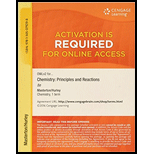
CHEMISTRY:PRIN.+REACTIONS-OWLV2 ACCESS
8th Edition
ISBN: 9781305079298
Author: Masterton
Publisher: Cengage Learning
expand_more
expand_more
format_list_bulleted
Concept explainers
Textbook Question
Chapter 19, Problem 13QAP
What is the mass percent of sulfur in the [Ag(SCN)2-]complex ion?
Expert Solution & Answer
Want to see the full answer?
Check out a sample textbook solution
Students have asked these similar questions
Seee the attached ima
Please see the attached image.
Please see the attached image.
Chapter 19 Solutions
CHEMISTRY:PRIN.+REACTIONS-OWLV2 ACCESS
Ch. 19 - Prob. 1QAPCh. 19 - Prob. 2QAPCh. 19 - Prob. 3QAPCh. 19 - Platinum(II) forms many complexes, among them...Ch. 19 - Prob. 5QAPCh. 19 - What is the coordination number of the central...Ch. 19 - Prob. 7QAPCh. 19 - Prob. 8QAPCh. 19 - Prob. 9QAPCh. 19 - Prob. 10QAP
Ch. 19 - Prob. 11QAPCh. 19 - Prob. 12QAPCh. 19 - What is the mass percent of sulfur in the...Ch. 19 - Prob. 14QAPCh. 19 - There are four iron atoms in each hemoglobin...Ch. 19 - Vitamin B12 is a coordination compound with cobalt...Ch. 19 - Prob. 17QAPCh. 19 - Prob. 18QAPCh. 19 - Name the following ions or compounds (a)...Ch. 19 - Name the following ions or compounds (a)...Ch. 19 - Prob. 21QAPCh. 19 - Prob. 22QAPCh. 19 - Sketch the geometry of (a)...Ch. 19 - Sketch the geometry of (a) tans-[Cu(Br)2(H2O)4]...Ch. 19 - Prob. 25QAPCh. 19 - Prob. 26QAPCh. 19 - Which of the following octahedral complexes show...Ch. 19 - Prob. 28QAPCh. 19 - Prob. 29QAPCh. 19 - Prob. 30QAPCh. 19 - Prob. 31QAPCh. 19 - Prob. 32QAPCh. 19 - Write an abbreviated orbital diagram and determine...Ch. 19 - Prob. 34QAPCh. 19 - Give the electron distribution in low-spin and/or...Ch. 19 - Prob. 36QAPCh. 19 - Prob. 37QAPCh. 19 - Prob. 38QAPCh. 19 - Prob. 39QAPCh. 19 - Prob. 40QAPCh. 19 - Give the number of unpaired electrons in...Ch. 19 - Prob. 42QAPCh. 19 - Ti(NH3)63+ has a d-orbital electron transition at...Ch. 19 - has a crystal field splitting energy, o, of...Ch. 19 - Prob. 45QAPCh. 19 - Prob. 46QAPCh. 19 - Prob. 47QAPCh. 19 - Prob. 48QAPCh. 19 - Prob. 49QAPCh. 19 - Indicate whether each of the following is true or...Ch. 19 - A child eats 10.0 g of paint containing 5.0% Pb....Ch. 19 - A certain coordination compound has the simplest...Ch. 19 - Prob. 53QAPCh. 19 - In the [Ti(H2O)63+] ion, the splitting between the...
Knowledge Booster
Learn more about
Need a deep-dive on the concept behind this application? Look no further. Learn more about this topic, chemistry and related others by exploring similar questions and additional content below.Similar questions
- V Biological Macromolecules Drawing the Haworth projection of an aldose from its Fischer projection Draw a Haworth projection of a common cyclic form of this monosaccharide: H C=O HO H HO H H OH CH₂OH Explanation Check Click and drag to start drawing a structure. Xarrow_forwardComplete the mechanismarrow_forwardComplete the mechanismarrow_forward
- 8 00 6 = 10 10 Decide whether each of the molecules in the table below is stable, in the exact form in which it is drawn, at pH = 11. If you decide at least one molecule is not stable, then redraw one of the unstable molecules in its stable form below the table. (If more than unstable, you can pick any of them to redraw.) Check OH stable HO stable Ounstable unstable O OH stable unstable OH 80 F6 F5 stable Ounstable X Save For Later Sub 2025 McGraw Hill LLC. All Rights Reserved. Terms of Use | Privacy C ཀྭ་ A F7 매 F8 F9 4 F10arrow_forwardJust try completing it and it should be straightforward according to the professor and TAs.arrow_forwardThe grading is not on correctness, so if you can just get to the correct answers without perfectionism that would be great. They care about the steps and reasoning and that you did something. I asked for an extension, but was denied the extension.arrow_forward
arrow_back_ios
SEE MORE QUESTIONS
arrow_forward_ios
Recommended textbooks for you
 Chemistry: The Molecular ScienceChemistryISBN:9781285199047Author:John W. Moore, Conrad L. StanitskiPublisher:Cengage Learning
Chemistry: The Molecular ScienceChemistryISBN:9781285199047Author:John W. Moore, Conrad L. StanitskiPublisher:Cengage Learning Chemistry: Principles and ReactionsChemistryISBN:9781305079373Author:William L. Masterton, Cecile N. HurleyPublisher:Cengage Learning
Chemistry: Principles and ReactionsChemistryISBN:9781305079373Author:William L. Masterton, Cecile N. HurleyPublisher:Cengage Learning ChemistryChemistryISBN:9781305957404Author:Steven S. Zumdahl, Susan A. Zumdahl, Donald J. DeCostePublisher:Cengage Learning
ChemistryChemistryISBN:9781305957404Author:Steven S. Zumdahl, Susan A. Zumdahl, Donald J. DeCostePublisher:Cengage Learning Chemistry: An Atoms First ApproachChemistryISBN:9781305079243Author:Steven S. Zumdahl, Susan A. ZumdahlPublisher:Cengage Learning
Chemistry: An Atoms First ApproachChemistryISBN:9781305079243Author:Steven S. Zumdahl, Susan A. ZumdahlPublisher:Cengage Learning
 Chemistry & Chemical ReactivityChemistryISBN:9781337399074Author:John C. Kotz, Paul M. Treichel, John Townsend, David TreichelPublisher:Cengage Learning
Chemistry & Chemical ReactivityChemistryISBN:9781337399074Author:John C. Kotz, Paul M. Treichel, John Townsend, David TreichelPublisher:Cengage Learning

Chemistry: The Molecular Science
Chemistry
ISBN:9781285199047
Author:John W. Moore, Conrad L. Stanitski
Publisher:Cengage Learning

Chemistry: Principles and Reactions
Chemistry
ISBN:9781305079373
Author:William L. Masterton, Cecile N. Hurley
Publisher:Cengage Learning

Chemistry
Chemistry
ISBN:9781305957404
Author:Steven S. Zumdahl, Susan A. Zumdahl, Donald J. DeCoste
Publisher:Cengage Learning

Chemistry: An Atoms First Approach
Chemistry
ISBN:9781305079243
Author:Steven S. Zumdahl, Susan A. Zumdahl
Publisher:Cengage Learning


Chemistry & Chemical Reactivity
Chemistry
ISBN:9781337399074
Author:John C. Kotz, Paul M. Treichel, John Townsend, David Treichel
Publisher:Cengage Learning
The Bohr Model of the atom and Atomic Emission Spectra: Atomic Structure tutorial | Crash Chemistry; Author: Crash Chemistry Academy;https://www.youtube.com/watch?v=apuWi_Fbtys;License: Standard YouTube License, CC-BY